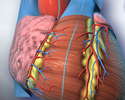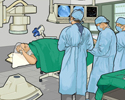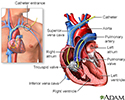Swan-Ganz - right heart catheterization
Right heart catheterization; Catheterization - right heart
Swan-Ganz catheterization is the passing of a thin tube (catheter) into the right side of the heart and the arteries leading to the lungs. It is done to monitor the heart's function and blood flow and pressures in and around the heart. This test is most often done in people who are very ill.
How the Test is Performed
The test can be done while you are in bed in an intensive care unit (ICU) of a hospital. It can also be done in special procedure areas such as a cardiac catheterization laboratory.
Cardiac catheterization
Cardiac catheterization involves passing a thin flexible tube (catheter) into the right or left side of the heart. The catheter is most often insert...

Before the test starts, you may be given medicine (sedative) to help you relax.
You will lie on a padded table. Your doctor will make a small surgical cut near the groin or in your neck. A flexible tube (catheter or sheath) is placed through the cut into a vein. Sometimes, it will be placed in your leg or your arm. You will be awake during the procedure.
A longer catheter is inserted. It is then carefully moved into the upper chamber of the right side of the heart. X-ray images may be used to help the health care provider see where the catheter should be placed.
Blood may be removed from the catheter. This blood is tested to measure the amount of oxygen in the blood.
During the procedure, your heart's rhythm will be constantly watched using an electrocardiogram (ECG).
Electrocardiogram
An electrocardiogram (ECG) is a test that records the electrical activity of the heart.

How to Prepare for the Test
You should not eat or drink anything for 8 hours before the test starts. You may need to stay in the hospital the night before the test. Otherwise, you will check in to the hospital the morning of the test.
You will wear a hospital gown. You must sign a consent form before the test. Your provider will explain the procedure and its risks.
How the Test will Feel
You may be given medicine to help you relax before the procedure. You will be awake and able to follow instructions during the test.
You may feel some discomfort when the IV is placed into your arm. You may also feel some pressure at the site when the catheter is inserted. In people who are critically ill, the catheter may stay in place for several days.
You may feel discomfort when the area of the vein is numbed with anesthetic.
Why the Test is Performed
The procedure is done to evaluate how the blood moves (circulates) in people who have:
- Abnormal pressures in the heart arteries
-
Burns
Burns
Burns commonly occur by direct or indirect contact with heat, electric current, radiation, or chemical agents. Burns can lead to cell death....
 ImageRead Article Now Book Mark Article
ImageRead Article Now Book Mark Article -
Congenital heart disease
Congenital heart disease
Congenital heart disease (CHD) is a problem with the heart's structure and function that is present at birth.
 ImageRead Article Now Book Mark Article
ImageRead Article Now Book Mark Article -
Heart failure
Heart failure
Heart failure is a condition in which the heart is no longer able to pump oxygen-rich blood to the rest of the body efficiently. This causes symptom...
 ImageRead Article Now Book Mark Article
ImageRead Article Now Book Mark Article - Kidney disease
-
Leaky heart valves
Leaky heart valves
Mitral regurgitation is a disorder in which the mitral valve on the left side of the heart does not close properly. Regurgitation means leaking from ...
 ImageRead Article Now Book Mark Article
ImageRead Article Now Book Mark Article - Lung problems
-
Shock
Shock
Shock is a life-threatening condition that occurs when the body is not getting enough blood flow. Lack of blood flow means that the cells and organs...
 ImageRead Article Now Book Mark Article
ImageRead Article Now Book Mark Article
It may also be done to monitor for complications of a heart attack . It also shows how well certain heart medicines are working.
Heart attack
Most heart attacks are caused by a blood clot that blocks one of the coronary arteries. The coronary arteries bring blood and oxygen to the heart. ...

Swan-Ganz catheterization can also be used to detect abnormal blood flow between two areas of the heart that are not normally connected.
Conditions that can also be diagnosed or evaluated with Swan-Ganz catheterization include:
-
Cardiac tamponade
Cardiac tamponade
Cardiac tamponade is pressure on the heart that occurs when blood or fluid builds up in the space between the heart muscle and the outer covering sac...
 ImageRead Article Now Book Mark Article
ImageRead Article Now Book Mark Article -
Pulmonary hypertension
Pulmonary hypertension
Pulmonary hypertension is high blood pressure in the arteries of the lungs. It makes the right side of the heart work harder than normal.
 ImageRead Article Now Book Mark Article
ImageRead Article Now Book Mark Article -
Restrictive cardiomyopathy
Restrictive cardiomyopathy
Restrictive cardiomyopathy refers to a set of changes in how the heart muscle functions. These changes cause the heart to fill poorly (more common) ...
 ImageRead Article Now Book Mark Article
ImageRead Article Now Book Mark Article
Normal Results
Normal results for this test are:
- Cardiac index is 2.8 to 4.2 liters per minute per square meter (of body surface area)
- Pulmonary artery systolic pressure is 17 to 32 millimeters of mercury (mm Hg)
- Pulmonary artery mean pressure is 9 to 19 mm Hg
- Pulmonary diastolic pressure is 4 to 13 mm Hg
- Pulmonary capillary wedge pressure is 4 to 12 mm Hg
- Right atrial pressure is 0 to 7 mm Hg
What Abnormal Results Mean
Abnormal results may be due to:
- Blood flow problems, such as heart failure or shock
- Heart valve disease
- Lung disease
-
Structural problems with the heart, such as a shunt from an atrial or
ventricular septal defect
Ventricular septal defect
Ventricular septal defect is a hole in the wall that separates the right and left ventricles of the heart. Ventricular septal defect is one of the m...
 ImageRead Article Now Book Mark Article
ImageRead Article Now Book Mark Article
Risks
Risks of the procedure include:
- Bruising around the area where the catheter was inserted
- Injury to the vein
-
Puncture to the lung if the neck or chest veins are used, causing lung collapse (
pneumothorax
)
Pneumothorax
A collapsed lung occurs when air escapes from the lung. The air then fills the space outside of the lung, between the lung and chest wall. This bui...
 ImageRead Article Now Book Mark Article
ImageRead Article Now Book Mark Article
Very rare complications include:
-
Cardiac
arrhythmias
requiring treatment
Arrhythmias
An arrhythmia is a disorder of the heart rate (pulse) or heart rhythm. The heart can beat too fast (tachycardia), too slow (bradycardia), or irregul...
 ImageRead Article Now Book Mark Article
ImageRead Article Now Book Mark Article -
Cardiac tamponade
Cardiac tamponade
Cardiac tamponade is pressure on the heart that occurs when blood or fluid builds up in the space between the heart muscle and the outer covering sac...
 ImageRead Article Now Book Mark Article
ImageRead Article Now Book Mark Article -
Embolism
caused by
blood clots
at the tip of the catheter
Embolism
Blood clots are clumps that occur when blood hardens from a liquid to a solid. A blood clot that forms inside one of your veins or arteries is calle...
 ImageRead Article Now Book Mark Article
ImageRead Article Now Book Mark ArticleBlood clots
Blood clots are clumps that occur when blood hardens from a liquid to a solid. A blood clot that forms inside one of your veins or arteries is calle...
 ImageRead Article Now Book Mark Article
ImageRead Article Now Book Mark Article - Infection
- Low blood pressure
References
Davidson CJ, Bonow RO. Cardiac catheterization. In: Mann DL, Zipes DP, Libby P, Bonow RO, Braunwald E, eds. Braunwald's Heart Disease: A Textbook of Cardiovascular Medicine . 10th ed. Philadelphia, PA: Elsevier Saunders; 2015:chap 19.
Kern M. Catheterization and angiography. In: Goldman L, Schafer AI, eds. Goldman's Cecil Medicine . 25th ed. Philadelphia, PA: Elsevier Saunders; 2016:chap 57.
Sturgess DJ. Haemodynamic monitoring. In: Bersten AD, Soni N, eds. Oh's Intensive Care Manual . 7th ed. Philadelphia, PA: Elsevier; 2014:chap 16.
-
Cardiac catheterization
Animation
-
Cardiac catheterization - indications
Animation
-
Swan Ganz catheterization - illustration
Right heart catheterization involves the passage of a catheter (a thin flexible tube) into the right side of the heart to obtain diagnostic information about the heart and for continuous monitoring of heart function in critically ill patients.
Swan Ganz catheterization
illustration
-
Swan Ganz catheterization - illustration
Right heart catheterization involves the passage of a catheter (a thin flexible tube) into the right side of the heart to obtain diagnostic information about the heart and for continuous monitoring of heart function in critically ill patients.
Swan Ganz catheterization
illustration
Review Date: 8/2/2016
Reviewed By: Michael A. Chen, MD, PhD, Associate Professor of Medicine, Division of Cardiology, Harborview Medical Center, University of Washington Medical School, Seattle, WA. Also reviewed by David Zieve, MD, MHA, Isla Ogilvie, PhD, and the A.D.A.M. Editorial team.




